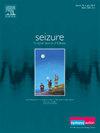一种新的致病变异导致以婴儿癫痫痉挛综合征为表现的儿童的pou3f3相关神经发育障碍:扩大癫痫表型
IF 2.8
3区 医学
Q2 CLINICAL NEUROLOGY
引用次数: 0
摘要
目的:POU3F3基因的致病变异是一种极其罕见的神经遗传疾病的原因,其特征是神经精神和全身表现的结合。约15%的患者有癫痫,范围从局灶性非运动敏感性癫痫发作(弹性和震颤性)到全身性运动和非运动性癫痫发作,包括强直-阵挛、强直、肌阵挛、无张力或非典型缺席。到目前为止,还没有婴儿癫痫性痉挛的病例与这种神经遗传疾病有关。方法报告1例20月龄男性患者,在出生4月龄时出现癫痫性痉挛,脑电图显示脑病模式,经颅底评分证实,伴有严重张力低下、小头畸形、脑畸形和多动性运动障碍,包括刻板印象和运动障碍。癫痫痉挛在ACTH周期后复发,对维加巴林治疗有反应。结果染色体组分析发现一种新的错义新生致病变异(C .1071 g >;C;p.Gln337His)在POU3F3基因中。结论本病例扩展了pou3f3相关神经发育障碍的癫痫表型,并有助于鉴定一个新的潜在基因,该基因参与了婴儿癫痫痉挛综合征的遗传病因。本文章由计算机程序翻译,如有差异,请以英文原文为准。
A novel pathogenic variant causing POU3F3-related neurodevelopmental disorder in a child presenting with infantile epileptic spasms syndrome: Expanding the epileptic phenotype
Purpose
Pathogenic variants in the POU3F3 gene are responsible for an ultra-rare neurogenetic disorder, characterized by a combination of neuropsychiatric and systemic manifestations. Epilepsy is observed in approximately 15 % of affected individuals, ranging from focal non-motor sensitive seizures (gelastic and dacristic) to generalized motor and non-motor seizures including either tonic-clonic, tonic, myoclonic, atonic or atypical absences. To date, no cases of infantile epileptic spasms have been associated with this neurogenetic condition.
Methods
We report on a 20 months male patient presenting at 4 months of life with epileptic spasms, encephalopathic pattern on EEG, confirmed by BASED score, severe hypotonia, microcephaly, cerebral malformation and hyperkinetic movement disorder, consisting of stereotypies and dyskinesias. Epileptic spasms relapsed after ACTH cycle and responded to treatment with vigabatrin.
Results
Exome analysis revealed a novel missense de novo pathogenic variant (c.1071G>C; p.Gln337His) in the POU3F3 gene.
Conclusions
This case expands the epileptic phenotype of the POU3F3-related neurodevelopment disorder and contributes to the identification of a novel potential gene, involved in the genetic etiology of Infantile Epileptic Spasm Syndrome.
求助全文
通过发布文献求助,成功后即可免费获取论文全文。
去求助
来源期刊

Seizure-European Journal of Epilepsy
医学-临床神经学
CiteScore
5.60
自引率
6.70%
发文量
231
审稿时长
34 days
期刊介绍:
Seizure - European Journal of Epilepsy is an international journal owned by Epilepsy Action (the largest member led epilepsy organisation in the UK). It provides a forum for papers on all topics related to epilepsy and seizure disorders.
 求助内容:
求助内容: 应助结果提醒方式:
应助结果提醒方式:


